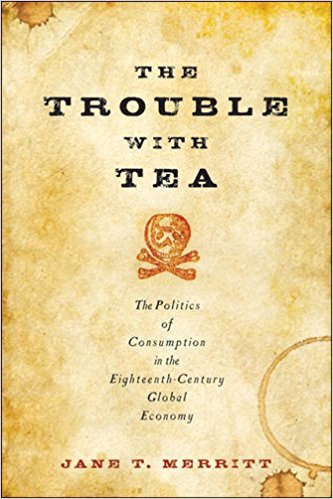PEAES Book Series
Series Editor’s Foreward

The Trouble with Tea The Politics of Consumption in the Eighteenth-Century Global Economy, by Jane T. Merritt (Baltimore: The Johns Hopkins University Press, 2016)
This addition to the series Studies in Early American Economy and Society, a collaborative effort between Johns Hopkins University Press and the Library Company of Philadelphia’s Program in Early American Economy and Society (PEAES), takes readers on a journey of new discoveries about the political economy of one of the world’s most widely used commodities: tea. Jane Merritt’s compelling study, The Trouble with Tea, places tea not only in the homes of myriad North Americans during the eighteenth century, but also traces the role of tea at the center of global events encompassing Atlantic revolutions and imperial contests during the century’s closing years. As her story unfolds, readers see how through the lens of a commodity – its growth, processing, trade, and consumption — continents of early modern peoples were interconnected by their trade for this highly desirable item.
Many readers are undoubtedly accustomed to placing tea within the narrative of the North American Revolution’s approaching declaration of independence from British taxation and political might. In addition to the dramatic Tea Parties of 1773, waves of colonial nonimportation boycotts of tea and other articles of “necessity” in the colonial economy sparked deepening tests that challenged the rights of Britain to control the North American colonial economies. The cries of “no taxation without representation” seemed to be a firm, definitive renunciation of British efforts to undermine hard-won economic opportunities and political rights. Merritt agrees with many scholars that nonimportation movements that tea was one of the powerful instruments of symbolic and political economic protest in the final colonial years. But she takes our understanding much farther back in time, and more deeply into global commercial relationships than interpretations about the immediate imperial crisis permit. She insists on a wider narrative that includes India and Asia as equally important centers of the British empire’s trade as well as trans-national economic imperialism and local resistance. And for decades before the 1760s, she argues, tea was key to the expansion of imperial trade networks and the introduction of new goods and ideas that few colonists or imperial policy makers understood in those years.
The ubiquity of tea consumption by the 1760s had a long and troubled rise. Widespread doubts about spending on the commodity and consuming it across class lines only slowly transformed into acceptance, then eagerness. Tea became one of many new commodities that filled the coffers of trading merchants, seemed to cultivate refined taste among consumers, and called forth the need to use new kinds of bookkeeping, credit instruments, navigation equipment, and shipping strategies. The English East India Company became a behemoth, largely in the context of expanding tea trading. And as Merritt argues, tea was one of the important exotic goods that “stirred the English commercial imagination.”
But although tea spurred more extensive commerce into relatively unknown parts of the world, which in turn deepened Britain’s (including the colonies’) claims of dominion in far flung places around the world, tea also inflamed tensions between traders, middlemen, and policy makers in different cultures. It was no minor task to navigate the schoals of global markets where culture and language differences provided constant obstacles to open trading. Pushing our perspective beyond the popular Atlantic World paradigm, Merritt demonstrates that the political economy of settled British imperial cities and frontiers – including the colonies of the Western Hemisphere – was in fact deeply dependent on the connections, credit, and silver economies within the orbit of India and Asia. The demand for tea in the Western Hemisphere and Europe, however, was not evenly and happily welcomed by China’s premier tea traders. Regulations about who could enter China’s trading arenas and restrictions about how, and whether, European merchants could trade at Canton sustained a level of commercial anxiety that was only intermittantly relieved with Chinese people’s own demands for externally produced goods and the ever-necessary silver specie Europeans brought in their ships.
In addition, Merritt’s study moves readers beyond a familiar story in which consumers in Europe and North America seemed to have a “natural” propensity for drinking tea, that somehow, the growing market for that commodity did not need much of a jump start before an unstoppable desire for tea unfolded. She shows that like other imperially integrated commodities markets, tea’s success was never assured and it always had a complex history of commercial risks, technological changes, adaptations of labor regimes and slave trading, merchant network building, and much more. Any of the links from agricultural cultivation to tea time consumption could snap, and for decades many of them did. It was never a foregone conclusion that tea, among other new goods entering daily lives by the mid-eighteenth century, would propel forward the consumer revolution that increased the circulation of goods, gave myriad people new choices, became recognizable to everyone before the American Revolution.
Cathy Matson
University of Delaware and Director,
Program in Early American Economy and Society
